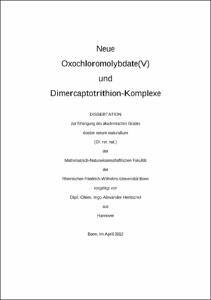Neue Oxochloromolybdate(V) und Dimercaptotrithion-Komplexe

Neue Oxochloromolybdate(V) und Dimercaptotrithion-Komplexe

| dc.contributor.advisor | Beck, Johannes | |
| dc.contributor.author | Hentschel, Ingo-Alexander | |
| dc.date.accessioned | 2020-04-18T01:02:41Z | |
| dc.date.available | 2020-04-18T01:02:41Z | |
| dc.date.issued | 18.09.2012 | |
| dc.identifier.uri | https://hdl.handle.net/20.500.11811/5370 | |
| dc.description.abstract | Die vorliegende Arbeit befaßt sich mit der Darstellung und Charakterisierung von Oxochloromolybdate(V) und Dimercaptotrithion-Komplexen. Die Oxochloromolybdate(V) wurden via Lewis-Säure-Base Reaktion in evakuierten Glasampullen unter solvothermalen Bedingungen und die Dimercaptotrithion-Komplexe nach der Methode der diffusionsgesteuerten Grenzflächenreaktion synthetisiert. Die Charakterisierung der Produkte erfolgte mit Hilfe der Elementaranalyse und der Methode der Röntgendiffraktometrie. Bei den Oxochloromolybdate(V) konnten neben der Substanzklasse der Alkalitetrachlorooxomolybdate(V) der allgemeinen Zusammensetzung M[MoOCl4](M = Li+, Na+, K+, Rb+, und Cs+) auch zwei neue Vertreter der Alkaliheptachlorodioxodimolybdate(V) der Zusammensetzung M[Mo2O2Cl7] (M = Rb+ und Cs+) synthetisiert werden. Die Verbindungen M[MoOCl4] unterscheiden sich in zwei verschiedene Koordinationsmuster der [MoOCl4]--Anionen. Der Unterschied bei den M[Mo2O2Cl7] besteht in der Stereochemie der zweikernigen [Mo2O2Cl7]- Anionen. Desweiteren konnten schwarze nadelförmige Kristalle von (TTF)[MoOCl4] erhalten und kristallographisch aufgeklärt werden. Hier konnte neben dem planaren Tetrathiofulvalenyl-Radikalkation die gewünschten polymeren [MoOCl4]--Stränge erhalten werden. Weitere Untersuchungen zur Charakterisierung wurden durch magnetische Messungen und der Messung der elektrischen Leitfähigkeit durchgeführt. Werden die Erdalkalichloride mit MoOCl3 in Thionylchlorid umgesetzt erhält man smaragdgrüne Einkristalle der Zuammensetzung [M(SOCl2)2(MoOCl4)2] (M = Mg2+, Ca2+ und Sr2+). In den Erdalkalioxochloromolybdat(V)-SOCl2-Solvaten führt die Koordination der Polyeder zu unterschiedlichen eindimensionalen Strängen in den Strukturen. In der Bariumverbindungen liegen dagegen neben Ba2+-Kationen isolierte Oxopentachloromolybdat-Anionen [MoOCl5]- vor. Neben den bereits sehr gut untersuchten Dimercaptoisotrithion-Komplexen fand der isomere Dimercaptotrithion-Ligand in der Dithiolen-Chemie bisher sehr wenig Beachtung. Hier konnte neben einem Kupfer-Bis-Chelat-Komplex ein dreikerniger Kupfer-Komplex der Zusammensetzung (P(C4H9)4)[Cu3(dmt)3] isoliert werden. In der Struktur sind die nahezu planaren, dreikernigen [Cu3(dmt)3]--Anionen über gemeinsame (S-S)-Wechselwirkungen assoziiert. Eine magnetische Messung und die Messung der elektronischen Leitfähigkeit rundeten die Charakterisierung dieses Komplexes ab. | en |
| dc.description.abstract | The present work deals with the representation and characterization of Oxochloromolybdate(V) and Dimercaptotrithion complexes. Oxochloromolybdate(V) were synthesized via a Lewis-acid-base reaction in evacuated glass ampoules under solvothermal conditions,while Dimercaptotrithion complexes were formed by the method of the diffusion-steered interface reactions. All substances were produced in form of their crystals and were characterised by elemental analysis and single-crystal x-ray diffraction. The reaction of molybdenum oxytrihalide MoOCl3 with alkali halides leads to compounds of the general formula M[MoOCl4] (M = Li+, Na+, K+, Rb+, and Cs+). The [MoOCl4]--anions connect in two different patterns of coordination. Two new representatives of the Alkaliheptachlorodioxodimolybdate(V) of the composition M[Mo2O2Cl7] with M = Rb+ and Cs+ were discovered. The difference of these compounds was the Stereochemistry of the dinuclear [Mo2O2Cl7]--anions. The reaction of molybdenum oxytrihalides MoOCl3 with earth-alkali chlorides leads to compounds of the chemical composition M(SOCl2]2(MoOCl4)2] (M = Mg2+, Ca2+ and Sr2+). The earthalkalioxochloromolybdat(V)-SOCl2-solvate connect in one-dimensional single strands consisting of [Mo2O2Cl8]2--anions and to different earth-alkali coordination polyhedra. MoOCl3 with BaCl2 reacts to compound of the formula Ba[MoOCl5]. The [MoOCl5]--octahedra indicates in diffrent direction. Furthermore black needle-shaped crystals of Tetrathiofulvalenyl-tetrachlorooxomolybdat(V) (TTF)[MoOCl4] could be obtained. Here, in addition to the planar tetrathiafulvalenyl radical cation the desired polymer [MoOCl4]- strands could be located. The real structure consists of square-pyramidal [MoOCl4]- ions stacked to form columns with alternating O-Mo distances of 164,2 and 239,7 pm. The packing of the columns is disordered in that the [MoOCl4]- pyramids point either in the +a or -a direction. Further studies on the characterization were performed by magnetic measurements and the measurement of the electrical conductivity. The complexes of the isomeric Dimercaptotrithion-ligand (Dmt) are not well-known. Down to the present day only five compounds are characterised. Here, a copper-chelate complex of composition (P(C4H9)4)[Cu3(dmt)3] was isolated. In the nearly planar structure of trinuclear [Cu3(dmt)3]--anions are associated with sulphur sulphur interactions. Measurements of the magnetic and electronic conductivity were used to further characterize this complex. | en |
| dc.language.iso | deu | |
| dc.rights | In Copyright | |
| dc.rights.uri | http://rightsstatements.org/vocab/InC/1.0/ | |
| dc.subject | Einkristallstrukturanalyse | |
| dc.subject | Struktur-Eigenschafts-Beziehungen | |
| dc.subject | Oxochloromolybdate(V) | |
| dc.subject | Dithiolen-Komplexe | |
| dc.subject | DFT-Rechnung | |
| dc.subject | Paramagnetismus | |
| dc.subject | Diamagnetismus | |
| dc.subject | Dithiolene-Chemistry | |
| dc.subject | Paramagnetism | |
| dc.subject | Diamagnetism | |
| dc.subject | DFT-Calculation | |
| dc.subject | X-ray analysis | |
| dc.subject.ddc | 540 Chemie | |
| dc.title | Neue Oxochloromolybdate(V) und Dimercaptotrithion-Komplexe | |
| dc.type | Dissertation oder Habilitation | |
| dc.publisher.name | Universitäts- und Landesbibliothek Bonn | |
| dc.publisher.location | Bonn | |
| dc.rights.accessRights | openAccess | |
| dc.identifier.urn | https://nbn-resolving.org/urn:nbn:de:hbz:5n-29587 | |
| ulbbn.pubtype | Erstveröffentlichung | |
| ulbbnediss.affiliation.name | Rheinische Friedrich-Wilhelms-Universität Bonn | |
| ulbbnediss.affiliation.location | Bonn | |
| ulbbnediss.thesis.level | Dissertation | |
| ulbbnediss.dissID | 2958 | |
| ulbbnediss.date.accepted | 17.08.2012 | |
| ulbbnediss.institute | Mathematisch-Naturwissenschaftliche Fakultät : Fachgruppe Chemie / Institut für Anorganische Chemie | |
| ulbbnediss.fakultaet | Mathematisch-Naturwissenschaftliche Fakultät | |
| dc.contributor.coReferee | Mader, Werner |
Dateien zu dieser Ressource
Das Dokument erscheint in:
-
E-Dissertationen (4369)




